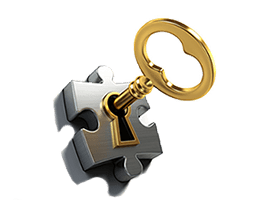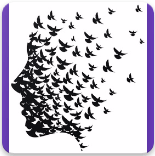K N O W L E D G E
Repression
Information about the repression of emotions.
Repression – Information
8 min reading time.
Here you will find background knowledge about repressions. If you want to treat a repression, visit this page.
Repression is generally said to be unconscious, whereas suppression is said to be conscious.
Repression – Background
Not only the external reality, but also the internal reality can often be too hard, too overwhelming, unbearable and also completely overwhelming for an early childhood, tender and open being. Be it the intense intensity of pain, the overwhelming helplessness, the deprivation, i.e. the deprivation of elementary basic needs such as love, affirmation, attachment, affection, tenderness or relentless, never-ending fears of loss or existence. In these early years, especially between birth and four years, such events can be so damaging and destructive that they can lead to a breakdown of the psyche or even death. In order to avoid this, to ensure inner and outer survival and to maintain functionality, such overwhelming and unbearable aspects such as hatred, anger, feelings, fears, cognitions (beliefs) etc. are repressed and shifted into the subconscious. As a result, they are excluded from consciousness and one’s own experience.
This is not a mental trick, as Arthur Janov (1924, American psychologist and author) wrote (“Caught in Pain”) , but a reaction of the entire organism, in which the brain and body work together. As an adult, many of these aspects would certainly have been bearable, but not as a baby or toddler. Because back then we were still without reason, theories, faith or hope that could explain or make sense of the situation and thus relieve us of the tension. We were only in the moment with the overwhelming pain, the horrible fear and also without any knowledge of whether the situation or the overwhelming feelings would ever end.
The function of repression is therefore to mitigate excessively painful, overwhelming, unendurable or unacceptable emotions (fears, anger, sadness, shame, etc.), realizations, conflicts, internal and external injuries (e.g. mental and physical abuse, humiliation, devaluation), the non-fulfillment or violation of basic needs and the resulting stress, or to secure the situation. It is therefore a matter of survival, protection and relief of the psyche in order to maintain general functioning and to ensure the development and preservation of inner stability and security. Almost all mental objects of perception such as emotions (fear, shame, anger, sadness, etc.) and cognitions (beliefs) can be suppressed.
Arthur Schopenhauer (1788 – 1860, German philosopher, author and university lecturer) is often regarded as a precursor of Sigmund Freud (1856-1939, neurologist, depth psychologist, cultural theorist, critic of religion and founder of psychoanalysis) and there is some evidence in his work that he already pre-formulated what Freud later regarded as repression. The “wisdom of the people” has also always known about the possibility and tendency in people to block out the unwanted, overwhelming or even unpleasant. The concept of repression can also be found in certain Eastern wisdom teachings, in the Bible, among South and Central American shamans and North American Indians, but none of them delved as deeply and in as much detail as Freud. His development of the concept of repression, which is a pathogenic, i.e. disease-causing process, became a central component of psychoanalytic theory and has since been confirmed empirically (“Psychoanalyse und Empirie.”, Arnold Langenmayr (ed.), Christoph Werner (ed.), Vandenhoeck Ruprecht Verlag”). According to Freud, psychoanalysis aims to make these unconscious aspects conscious again.
Repression is a psychological defense mechanism and is related to biological defense mechanisms. In the case of an allergic reaction, for example, we see that the body itself immediately develops an antibody to fight the intruder. This defense substance is now developed in such a way that it renders the intruder harmless, fends off the attack and thus keeps the organism in a state of equilibrium. Negative feelings, overwhelming, hurtful knowledge, anger, hatred, pain – these are also aspects that can cause considerable damage to the organism, especially in the early years, and therefore there are also psychological defense mechanisms for these mental or psychological elements, as well as for bacteria, viruses, etc. The repression of a certain element such as a feeling, a fear or even a cognition means that it is no longer perceptible. These elements are repressed and shifted into the unconscious, where they develop a strong, powerful dynamic with destructive effects. Freud’s student, Carl-Gustav Jung (1875-1961, Swiss psychiatrist and founder of analytical psychology), called these repressed parts “shadows”, because after repression they are actually alienated, but continue to cling to us like a real (light) shadow.
The dynamic that now arises from every repression leads to these effects of repression having an extremely strong and damaging impact on us and our lives. This is because the conflicts are only pseudo-solved with the repression; they remain active and push back into our consciousness, threatening to become conscious again. As a result, every repression acts as a stressor on the organism from within, burdening it and creating anxiety and tension. The effects become a self-destructive force, which is the cause of almost all human problems and which, if left untreated, ends in physical symptoms and illness. But since the repressions are unconscious, we cannot recognize the true cause of the problems. As a result, the real trigger usually remains (literally) in the dark and efforts to change something are unsuccessful, at least in the long term.
The two sides of repression
It was only through repression that we were able to survive the traumas of our childhood; they saved our lives. But shifted into the unconscious, they begin to sabotage and destroy us and our lives. The unconscious, the reservoir of all repressions, was also simply called “id” by Freud because of its alienation and has always been regarded by poets, artists and all cultures as the fear-inducing unknown, the dark side, the sinister and also the evil in a person’s life. But as dark as it is painted and viewed, this worst, this lowest also harbors the highest in man. We see this polarity particularly well in the story of Dr. Jekkyl and Mr. Hyde, the good and lovable man who turns into a beast at night. Among others, Milton H. Erickson (1901-1980, American psychiatrist, psychologist and psychotherapist), after gaining access to the unconscious through hypnotherapy, saw it less as the source of neuroses and more as something positive: as an immense, almost uncanny source of power, where, among other things, the creative abilities for self-healing lie. If we save our lives through repression and the repressed now begins to destroy our lives, it is only because it wants to be dealt with. It wants to be heard, it wants to be made conscious. It is a wound that wants to be healed. When it is healed, not only the harmful effects such as blockages and defense mechanisms fall away, but also the inner, deep tensions.
The realization of the polarities was also addressed earlier, in the West as well as in the East, as these two quotes show:
“If you bring forth what is within you, what is within you will save you. If you do not bring forth what is in you, what is in you will destroy you”, Apocryphal (synoptic, partly Gnostic) Gospel of Thomas, verse 70.
“To him who has conquered the mind, the mind is the best friend; but to him who has failed to do so, the same mind becomes the greatest enemy.” –( Bhagavad Gita 6.6, central scripture of Hinduism, approx. 200-500 BC)
And even if a psychologist like Miller says the following in this day and age, we should be aware that something essential is at stake here. :
“The life-saving function of repression in childhood later turns into a life-destroying power in adults.” Alice Miller (1923-2010), Swiss author and psychologist
Working on repression is essentially undoing/dissolving what was previously rejected. In doing so, we reintegrate our rejected elements, we make ourselves whole. Whole is another word for healing. So we heal ourselves at the deepest level. And this level influences pretty much everything in us and in our lives. But we are completely unaware of it.
Cause of repression
“Trauma is the most avoided, ignored, denied, misunderstood and untreated cause of human life.” Peter Levine (*1942, biophysicist and psychologist)
The trauma
Most repression arises from trauma. According to biophysicist and psychologist Dr. Peter Levine (1942), probably the best-known trauma expert, this phenomenon is difficult to define. He assumes that traumatic situations and the aspects that arise internally as a reaction are ultimately too overwhelming and create too much stress, so that we can no longer deal with them or our system, our psyche, can no longer process them. These are situations where something is too hurtful, too overwhelming, too much, too fast, so that we can no longer process it or our physical boundaries are violated too much. If normal processing (motoric discharge, reacting or responding (crying, speaking out, etc.)) does not succeed or is not possible at all, there is no choice but to repress the overwhelming element and thus shift it into the unconscious. According to Levine’s own statements, his most important insight is that people, especially children, can be overwhelmed by events that are usually considered normal and commonplace. So it doesn’t just have to be physical, psychological or sexual abuse, any situation can be traumatizing, especially for a small child, if it is subjectively seen or perceived as life-threatening or overwhelming. It has now also been proven that a series of seemingly harmless mishaps can have a long-term damaging effect and lead to trauma.
However, it is precisely infancy, early childhood, upbringing, contact or relationships with parents or those raising the child that can provide a wealth of causes for repression: No or inadequate empathy, resonance, affirmation, acceptance, tenderness or lack of love, excessive demands, harshness, fears, coldness, devaluation, condemnation, control or desires of the people raising the child, etc., but also phenomena such as falls, illnesses, minor injuries, being left alone, prolonged immobilization, loud noises, birth stress, etc…, In short, anything that intimidates, unsettles, offends, inhibits, burdens or injures the child, deprives it of its independence, can ultimately be suppressed if it is too stressful or overtaxing for the psyche. Even a fall while playing or from a bicycle can be traumatizing under certain circumstances. In addition to traumas, there are also microtraumas.
Here, too, overstraining aspects have been repressed, but not quite as strongly as in the case of trauma and with less intensity. So we can have a “good” childhood, with no big, bad event, accident, etc. and still be traumatized from the neck to the head. It is traumatic for any child, for example, to be left alone for several hours at the age of around one month. Psychological or emotional abuse can also often be quite undramatic events, such as being ignored. If the parents constantly or repeatedly disregard the child, this can lead to a traumatic atmosphere. The same applies if, for example, the child is constantly humiliated, embarrassed, misled, unsettled, overwhelmed, shamed, cursed, ignored, rejected or manipulated by their parents. Such psychological abuse is compounded by the experiences, feelings, fears, shame and sadness of not being loved.
Traumas lead to disturbed development
Trauma causes us to lose our connection to ourselves, to our body and also to the rest of the world. This loss is difficult to recognize, as the connection can also be severed very slowly. We then adapt without even realizing it. This is why we talk about the “hidden” effects of trauma. We may simply no longer feel so good, our well-being, our state of mind, our self-confidence, our self-esteem, our vitality, strength, energy and also our vibrancy, our drive is slowly and gradually diminished and weakened. Most severe traumas and repressions occur in infancy and early childhood up to around 5 years of age; we grow up with them and hardly notice these slow changes, if at all.
Trauma in a historical context: If we look at human history, we can see that humans have always had to fight for survival. For thousands of years he had to fight, hunt and poach for his food. In such dangerous food procurement, especially in fights with animals, man often found himself in situations where survival was at stake. The basic, unavoidable biological reactions to such situations are fight, flight or freeze (the so-called “dead man’s reflex”). A great deal of energy and strength is released during fight or flight. Of course, this huge release of energy also involves other things: high levels of tension, especially in the muscles, stress, the blood is pumped through the body with maximum strength and pressure, hormones of all kinds are released, the heart rate and breathing are accelerated, etc. All so that we have more energy and strength to fight. All so that we have more energy and strength to fight or flee and also so that we no longer feel fear or injury. Normally this excitement, this energy, is dissipated through fight or flight. But if there is no fight or flight, this immense trauma energy is still in the system with the tension, high blood pressure and stress that has been released. When an unbearable level of arousal is reached, an emergency brake is activated. The parasympathetic nervous system is then activated and triggers a freezing reaction (“dead stop reflex”). Our organism thus remains physiologically in shock. It is fixed either in torpor or at a high level of arousal. According to Levine, animals shake themselves free of this energy after such situations. Humans do not have this possibility and thus fix it in the nervous system and are displaced with the overwhelming feelings, fears or realizations/convictions. In this way, at least superficially, the person gets rid of the escape or trauma energy, the tension and also all aspects that cannot be processed.
The problem is, as I said, that this repressed flight or fight energy, which after all can bring people incredible strength, is combined with the repressed, overstraining aspects, such as the fear of dying or the feeling of helplessness with the high tension within us. But not only in the unconscious, but also in the body, because the repression becomes a tension in the body, which we can feel from a certain degree as hardening, tension or tenseness. As Wilhelm Reich (1897-1957, Austrian psychiatrist, psychoanalyst, sex researcher and sociologist) in particular showed, the repressions settle into the deepest levels of the muscle layers and even deform the body (see character structures according to W. Reich and A. Lowen). And if these tensions go so deep, then you can imagine that these tensions also strongly influence your basic state, your consciousness, as you perceive it every moment. The more tense your body is, the more restless you, or your basic state, will be. And not just temporarily, but permanently. The problem, however, is that we grew up with this tension and got used to it. We got used to them until they became normal to us, or our basic state is simply “normal” and we no longer feel these tensions. It is only when we dissolve repressions that we become aware of them and then, as a result of the dissolution, we become more relaxed, looser, more fluid and more alive. The energy increases, we become clearer and more conscious and yet we develop more and more deep relaxation and thus deep peace.
“A resolved trauma is a great gift that leads us back to the natural world of ebb and flow, to harmony, love and compassion.”, Dr. Peter Levine
Prenatal trauma generally has a very strong effect. It can often be seen that a general primal mistrust develops and those affected are already very restless, irritable, overactive and dissatisfied from babyhood onwards. The primal experience of birth can also bring many negative feelings for the child, such as (existential) fears, helplessness, pain, suffocation, etc., and thus also suppress them.
Fortunately, there are now simple and convenient methods for thoroughly dissolving repressions. If you want to do this, visit this page.
“Das Denken wird die Angst nicht überwinden, wohl aber das Handeln.”

Fear Therapy
Effective fear treatment in an app!
Effective content and techniques for treating fears/anxiety.
Thoroughly dissolve any fear, including the associated negative cognition/belief!
No direct confrontation (exposure) with the fear!
Also deals with individual cognitions and all other emotions such as shame, sadness, hate, anger, etc.
Buy the "Fear Therapy" app now for just 19.99 Euros!
Available in the Apple™ App Store or in the Google™ Playstore.


For all questions ...
... please do not hesitate to contact us. Whether it's a question of understanding, product details or questions about treatment.
We are happy to help!

„The great challenge of life lies in overcoming the limits within yourself
and to go as far as you would never have dreamed possible.“.”
Paul Gauguin (1848-1903), French painter, co-founder of Synthetism and pioneer of Expressionism



